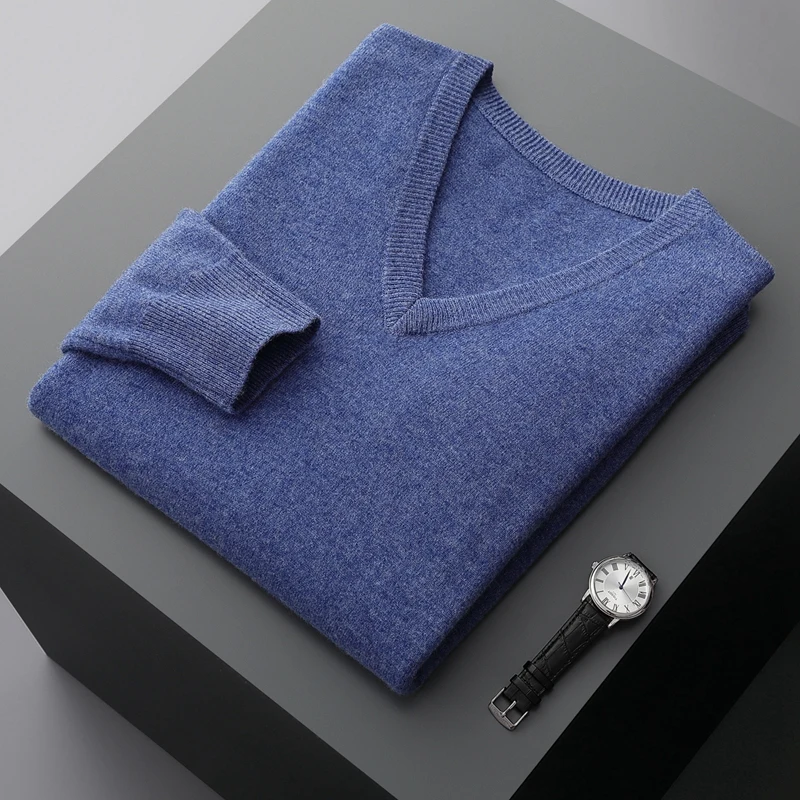Why Proper Cashmere Care Matters
Cashmere stands apart in the world of luxury fibers. Made from the soft undercoat of cashmere goats, premium Grade A cashmere fibers measure less than 16 microns in thickness—about one-fifth the diameter of human hair. This exceptional fineness creates the legendary softness and lightweight warmth that makes cashmere so coveted, but it also requires special attention when cleaning.
The way you care for your cashmere directly impacts how long it will remain beautiful. With proper maintenance, a quality cashmere sweater can remain soft and luxurious for over a decade, becoming more comfortable with each year. Conversely, incorrect washing methods can quickly destroy the delicate fibers, leading to shrinkage, stretching, pilling, and that dreaded scratchy feeling that turns a premium garment into an unwearable disappointment.
Many cashmere owners mistakenly believe their garments always require professional dry cleaning. This common myth not only costs you money but may actually shorten your sweater’s lifespan. The chemicals used in dry cleaning can strip cashmere of its natural oils, leading to drier, more brittle fibers over time.
Understanding proper cashmere care offers several benefits:
- Preserves the natural elasticity and softness of the fibers
- Maintains the garment’s shape and fit
- Prevents excessive pilling and fiber damage
- Extends the wearable life of your investment pieces
- Reduces the environmental impact of frequent replacements
Learning to properly clean your cashmere at home isn’t just about saving money—it’s about preserving the integrity of these remarkable fibers. A thorough understanding of comprehensive cashmere care and washing techniques will help ensure your favorite pieces remain treasured companions for many years.
Before diving into specific cleaning methods, let’s explore what makes your cashmere sweaters unique and how to assess their individual care needs.
Understanding Your Cashmere Before Cleaning
Not all cashmere is created equal, and understanding the specific qualities of your garment helps determine the best cleaning approach. The highest quality cashmere—Grade A—features fibers under 16 microns in thickness with lengths exceeding 36mm. This superior fiber quality responds differently to cleaning than lower grades with shorter, coarser fibers.
When assessing your cashmere sweater before cleaning, consider these key factors:
- Ply count: Single-ply cashmere is more delicate and requires gentler handling than two-ply or multi-ply garments, which have multiple yarns twisted together for strength.
- Pure cashmere vs. blends: Pure cashmere needs more delicate treatment than cashmere blended with other fibers like wool, silk, or synthetic materials.
- Age and condition: Newer cashmere often has more natural oils, while well-worn pieces may require more careful handling.
- Color intensity: Deeply dyed colors might fade more readily and may benefit from color-preserving cleaning methods.
- Construction details: Embellishments, unusual seams, or decorative elements may require special attention.
To identify high-quality cashmere, gently stretch a small section of the garment—premium cashmere will spring back quickly. When rubbed between fingers, the fabric should feel incredibly soft without any scratchiness. Lower quality cashmere might initially feel soft but will typically develop significant pilling after just a few wears.
For cashmere blends, the cleaning approach may vary depending on what other fibers are present. Wool-cashmere blends, like those found in many cashmere wool cardigans, are often slightly more resilient than pure cashmere but still require careful handling.
Before proceeding with any washing method, it’s essential to understand your specific garment’s needs. The fiber quality, construction, and current condition all play vital roles in determining the safest cleaning approach for maintaining your sweater’s luxurious feel.
Essential Preparations Before Washing
Taking the time to properly prepare your cashmere sweater before washing can make the difference between successful cleaning and accidental damage. These preparation steps set the foundation for effective, safe cleaning.
Check the Care Label
Always start by examining the care label. While many cashmere items recommend dry cleaning only, this is often a precautionary suggestion rather than an absolute requirement. Look for these common care symbols:
- Hand wash symbol (hand in water): Safe for gentle hand washing
- Machine wash symbol with 30°C: Machine washable on delicate cycle with cold water
- Circle: Dry clean only (particularly important for structured garments or those with embellishments)
- Crossed-out symbols: Indicates methods to avoid
Inspect Your Sweater Thoroughly
Before washing, carefully examine your sweater for:
- Stains: Note their location and type for targeted pre-treatment
- Pills: Remove these before washing to prevent further matting
- Weak spots or holes: These may need repair before washing to prevent expansion
- Loose threads: Secure any loose ends to prevent unraveling
- Previous damage: Areas already weakened may need extra gentle handling
Pre-Treat Stains Carefully
For spot stains, gently blot (never rub) with cool water and a drop of mild detergent specifically formulated for wool or cashmere. Always test any stain solution on an inconspicuous area first, such as an inner seam, to ensure it won’t damage the fabric or cause color transfer.
Prepare Your Cleaning Area
Set up your washing area with:
– Clean, flat surface for pre-treatment
– Basin or sink free of any residue from other products
– Fresh, clean towels for drying
– Appropriate gentle detergent (wool wash, cashmere shampoo, or baby shampoo)
– Cool or lukewarm water (never hot)
– Mesh laundry bag if machine washing
Always turn your cashmere inside out before washing. This simple step protects the visible surface from friction that can cause pilling and preserves the garment’s appearance.
For detailed guidance on interpreting care labels and properly preparing different types of garments, our cashmere sweater care instructions provide specific information tailored to various styles. Additionally, knowing how to prevent and manage cashmere fuzz before washing can significantly improve your results.
Method 1: Hand Washing Cashmere (The Gold Standard)
Hand washing is widely considered the safest and most effective way to clean cashmere. This gentle method preserves the natural properties of the fibers while effectively removing dirt, oils, and odors without the mechanical stress of machine washing.
Why Hand Washing Works Best
Hand washing allows you to control every aspect of the cleaning process—from water temperature to the amount of agitation. This careful approach preserves the natural lanolin in cashmere fibers, which helps maintain their softness and water-resistance. It also prevents the fibers from felting (permanently binding together), which causes shrinkage and stiffness.
Step-by-Step Hand Washing Guide
Prepare your basin: Fill a clean sink or basin with cool to lukewarm water (never exceeding 86°F/30°C). Hot water can shock cashmere fibers, causing them to shrink and felt.
Add appropriate detergent: Mix in a small amount (about 1 teaspoon) of wool-specific detergent, cashmere shampoo, or baby shampoo. These gentle cleansers dissolve oils without stripping the natural lanolin. Avoid regular detergents, which often contain enzymes that break down protein fibers.
Submerge your sweater: Turn your sweater inside out, then gently place it in the water, allowing it to become fully saturated. Do not wring, twist, or rub the fabric.
Soak properly: Let your sweater soak for 10-15 minutes, occasionally pressing down gently to allow the soapy water to penetrate the fibers.
Gently agitate: Using a light touch, press the sweater against the sides of the basin in a gentle squeezing motion. Avoid rubbing, which can damage the fibers and cause felting. Focus on areas that typically accumulate more oils, like cuffs and collars.
Rinse thoroughly: Drain the soapy water and refill the basin with clean, cool water. Gently press the sweater to release detergent. Repeat this process 2-3 times until no soap remains, as residual detergent can attract dirt and irritate skin.
Remove excess water: Never wring or twist cashmere. Instead, carefully lift the sweater with both hands supporting it evenly, and press it against the side of the basin. Then lay it on a clean, dry towel.

For stubborn stains or special circumstances, you might consider when professional cleaning is appropriate. Our guide on hand washing vs. dry cleaning cashmere provides detailed comparisons to help you make informed decisions about your specific garments, especially for items like women’s cashmere pullovers that may have unique design features requiring special attention.
Method 2: Machine Washing Cashmere (When Appropriate)
While hand washing is ideal, machine washing can be appropriate for certain cashmere items when done with extreme care. This method works best for simpler styles without embellishments and those specifically labeled as machine-washable.
When Machine Washing Is Suitable
Consider machine washing only when:
– The care label specifically permits it
– The garment is pure cashmere without embellishments or unusual construction
– You’re comfortable with a slightly higher risk compared to hand washing
– You have a washing machine with reliable gentle/wool cycle options
– The cashmere item is not extremely valuable or irreplaceable
Machine Washing Guidelines
If you determine machine washing is appropriate, follow these critical steps:
Use a protective mesh bag: Always place your cashmere in a fine mesh laundry bag to minimize friction and movement during the cycle.
Select the right settings: Choose the gentlest cycle available—typically labeled “wool,” “hand wash,” or “delicate.” Set the water temperature to cold (never warm or hot), and select the lowest possible spin speed.
Use appropriate detergent: Add a small amount of wool-specific or cashmere detergent—about half the amount you would normally use for a similar-sized load.
Wash separately: Never wash cashmere with other items, even other delicates. Other materials can create friction that damages cashmere fibers.
Avoid fabric softener: Skip the fabric softener, which can coat cashmere fibers and reduce their natural softness over time.
Limit washing frequency: Even when machine washing is appropriate, minimize how often you wash your cashmere to reduce fiber stress.
Machine Washing Risks
Machine washing cashmere always carries higher risks than hand washing, including:
– Increased pilling from mechanical agitation
– Potential for felting if the water is too warm
– Greater likelihood of stretching from spin cycles
– Possible snags from contact with the drum or other items
For more detailed guidelines about machine washing different cashmere items, including men’s cashmere pullovers, our comprehensive guide on safely machine washing cashmere provides specific recommendations by garment type.
The Critical Drying Process for Cashmere
The drying process is arguably the most crucial step in cashmere care—even more important than the washing method itself. Improper drying can permanently damage even perfectly washed cashmere by stretching, shrinking, or misshaping the garment.
The Cardinal Rule: Never Tumble Dry
Cashmere should never be placed in a dryer, even on the lowest heat or air-dry setting. The tumbling action causes fibers to felt and mat together, while the heat can cause irreversible shrinkage. Even “no heat” settings create too much mechanical action for delicate cashmere fibers.
Proper Water Removal Technique
Towel rolling method: After washing, lay your cashmere flat on a clean, dry bath towel. Gently roll the towel with the sweater inside, pressing lightly to absorb water. Never twist or wring the sweater and towel together.
Replace with dry towel: Unroll and transfer your cashmere to a second dry towel, as the first will be quite damp. This significantly reduces drying time.
Flat Drying Process
Reshape while damp: While your sweater is still damp, gently reshape it to its original dimensions. Pay special attention to sleeves, collars, and hemlines. This is your opportunity to correct any stretching that may have occurred during washing.
Position properly: Lay the reshaped sweater flat on a dry, clean towel or mesh drying rack that allows air circulation. Ensure the surface is in a location away from direct sunlight, radiators, or heating vents, as heat can cause shrinkage and color fading.
Flip occasionally: For even drying, gently turn the sweater over once the top side feels mostly dry. This prevents moisture from becoming trapped against the bottom surface.
Be patient: Complete drying typically takes 24-48 hours depending on the weight of the cashmere and ambient humidity. Never attempt to speed the process with hair dryers or heaters.
Check before storing: Ensure your cashmere is completely dry before folding and storing. Even slightly damp cashmere can develop mildew or mold when stored.
For specialized techniques for drying different cashmere styles, including oversized cashmere sweaters that require special attention to maintain their intentional silhouette, our guide on delicate cashmere drying techniques provides targeted advice.
Removing Pills and Restoring Cashmere’s Softness
Even the highest quality cashmere will develop small pills (those tiny fabric balls) with wear. This natural occurrence happens as short fibers work their way to the surface and tangle together. Proper de-pilling and conditioning techniques can restore your cashmere’s smooth surface and luxurious softness.
Effective De-Pilling Methods
Cashmere comb: The gentlest option, designed specifically for fine knits. Hold the fabric flat with one hand while lightly brushing in one direction with the comb. Work systematically across the entire garment for consistent results.
Sweater stone: Made from pumice-like material, these stones gently remove pills without catching or pulling yarns. Use light pressure and short strokes on dry cashmere.
Electric fabric shaver: If using an electric option, choose one designed for delicate fabrics and use the lowest setting. Hold the fabric taut and move the device in smooth, continuous motions without pressing down.
When de-pilling, always work on a flat surface with the garment fully dried. Focus special attention on friction areas like underarms and sides where pills form most frequently.
Restoring Softness
If your cashmere feels stiff after washing, try these restoration techniques:
Steaming: Hold a garment steamer or steam iron (without touching the fabric) about 6 inches away from the cashmere. The gentle moisture helps relax fibers without wetting the garment.
Hair conditioner rinse: For very stiff cashmere, add a teaspoon of silicone-free hair conditioner to your final rinse water during the next washing. This mimics the effect of natural lanolin that might have been removed.
White vinegar rinse: Adding a tablespoon of white vinegar to your final rinse water helps remove all detergent residue that might be causing stiffness.

Proper cashmere sweater storage between wearings also helps maintain softness by giving fibers time to relax and recover their natural resilience.
Cashmere Wrap Sweaters, Women's Cashmere Pullovers
$75.89 Select options This product has multiple variants. The options may be chosen on the product pageCashmere Cable Knit Sweaters, Women's Cashmere Pullovers
Price range: $111.82 through $112.93 Select options This product has multiple variants. The options may be chosen on the product pageCropped Cashmere Sweaters, Women's Cashmere Pullovers
$155.77 Select options This product has multiple variants. The options may be chosen on the product pageOversized Cashmere Sweaters, Plus Size Cashmere Sweaters, Women's V-Neck Cashmere Sweaters
$136.87 Select options This product has multiple variants. The options may be chosen on the product page- Price range: $108.11 through $130.03 Select options This product has multiple variants. The options may be chosen on the product page
Striped Cashmere Sweaters, Women's Cashmere Pullovers
$139.68 Select options This product has multiple variants. The options may be chosen on the product page
Addressing Common Stains on Cashmere
Stains require prompt, targeted treatment to prevent them from setting permanently into cashmere fibers. Different types of stains demand different approaches for effective removal without damaging the delicate fabric.
Common Stain Treatment Guide
| Stain Type | Treatment Method | Products to Use | What to Avoid |
|---|---|---|---|
| Oil/Grease | Blot with absorbent powder (cornstarch, talc) before washing | Dawn dish soap (tiny amount), cashmere shampoo | Rubbing alcohol, which dries fibers |
| Coffee/Tea | Blot immediately with cool water, then mild soap solution | Wool-safe detergent | Hot water, which sets tannin stains |
| Red Wine | Blot with white cloth, then sparkling water | Salt to absorb (while still wet) | Club soda with sodium, which may set stain |
| Makeup | Oil-based makeup remover on a cotton pad | Gentle, oil-free makeup remover | Waterproof makeup remover with alcohol |
| Deodorant | White vinegar solution (1:4 with water) | Wool-safe detergent | Bleach, even color-safe versions |
| Food | Remove solids, then blot (don’t rub) | Enzyme-free detergent | Hot water, which can set protein stains |
Stain Treatment Best Practices
When addressing stains on cashmere, remember these essential guidelines:
Act quickly: The sooner you treat a stain, the higher your chances of complete removal.
Test first: Always test any stain treatment on an inconspicuous area like an inner seam first.
Work from outside in: When applying stain treatments, work from the outer edges toward the center to prevent spreading.
Blot, don’t rub: Rubbing can push stains deeper into fibers and cause felting.
Patient layering: Apply treatments in light layers with drying time between applications rather than using large amounts at once.
For particularly challenging stains or valuable garments like cashmere turtlenecks with complex construction, consult our detailed guide on how to remove stains from cashmere for specialized techniques based on garment type and stain composition.
Proper Cashmere Storage Between Seasons
Proper storage is essential for preserving your cashmere’s quality when not in regular use. Careful preparation and appropriate storage conditions protect your investment from moths, stretching, and other potential damage.
Pre-Storage Cleaning
Always clean your cashmere before long-term storage. Even invisible oils, food particles, or perspiration can attract moths and other pests. Follow the cleaning methods outlined earlier, ensuring items are completely dry before storing.
Folding Technique
- Lay flat on a clean surface: Start with the sweater face down.
- Fold arms back: Fold each arm straight back at the shoulder seam.
- Fold sides in: Fold each side toward the center by about one-third.
- Final fold: Fold in half from bottom to top, or into thirds for longer sweaters.
- Avoid harsh creases: Slightly rounded folds prevent permanent crease lines.
Storage Container Options
- Breathable cotton storage bags: Allow air circulation while protecting from dust.
- Acid-free tissue paper: Use between folds to prevent creasing.
- Cedar storage boxes: Natural moth deterrent without direct contact with fabric.
- Never use plastic: Sealed plastic containers trap moisture that can damage fibers.
Moth Prevention
Moths are attracted to natural fibers like cashmere. Protect your garments with:
– Cedar blocks or rings (refresh the scent by lightly sanding every few months)
– Lavender sachets (replace every 2-3 months as scent fades)
– Periodic airing (every 4-6 weeks during long storage)

For comprehensive guidance on seasonal transitions and storage techniques that prevent damage, our ultimate guide to cashmere care provides detailed recommendations for different storage durations and environmental conditions.
Extending Wear Between Washes
Quality cashmere actually benefits from not being washed too frequently. Overwashing can remove natural oils that give the fibers their characteristic softness and resilience. With proper care between wears, you can significantly extend time between full washings.
Daily Maintenance Practices
24-hour rest period: Allow cashmere to rest at least 24 hours between wearings to let fibers recover their shape.
Gentle brushing: Use a soft-bristled garment brush to remove surface dust and debris after wearing. Brush in one direction using light, short strokes.
Immediate spot treatment: Address small spots or stains immediately using the targeted spot-cleaning techniques mentioned earlier.
Steaming instead of washing: For cashmere that isn’t visibly soiled but needs refreshing, a light steaming (holding steamer 6 inches away) removes odors and relaxes wrinkles without washing.
Air out thoroughly: After wearing, hang your cashmere item on a padded hanger in a well-ventilated area for several hours before storing. Never hang for extended periods, which can stretch the fabric.
Layering for Protection
Wearing a light, breathable layer beneath your cashmere creates a barrier against body oils and perspiration. Fine cotton, silk, or technical base layers can significantly extend time between cleanings by preventing direct contact with skin.
Understanding how to prevent cashmere shrinkage can help you make informed decisions about when a full cleaning is necessary versus when spot cleaning or steaming might suffice.
When to Seek Professional Cashmere Care
While home cleaning is suitable for most cashmere items, certain situations call for professional expertise. Knowing when to entrust your garments to specialists can prevent irreparable damage to particularly valuable or complex pieces.
When Professional Cleaning Is Recommended
Consider professional dry cleaning when your cashmere garment:
- Has structural elements like shoulder pads or interfacing
- Features embellishments (beading, sequins, leather patches)
- Contains multiple types of materials or linings
- Has set-in stains that haven’t responded to gentle home treatments
- Is extremely valuable or irreplaceable
- Has special dyes that might run during water-based cleaning
- Is labeled “dry clean only” and you’re not confident about hand washing
Selecting a Quality Dry Cleaner
Not all dry cleaners have the expertise to handle fine cashmere. When selecting a professional:
- Ask if they have specific experience with cashmere garments
- Inquire whether they have hand-cleaning options (preferred over machine dry cleaning)
- Confirm they use cashmere-safe cleaning solvents
- Discuss any special concerns (stains, previous damage) before leaving the garment
- Request that they avoid pressing with high heat
Potential Downsides of Dry Cleaning
Be aware that frequent dry cleaning can have drawbacks:
– Harsh chemicals may gradually break down natural fibers
– Repeated cleaning can remove natural oils that give cashmere its softness
– Some solvents may leave residues that attract dirt
– The cost is significantly higher than gentle home washing
For best results, develop a relationship with a quality cleaner who understands the value of your cashmere investments and treats them with appropriate care.
What to Absolutely Avoid When Cleaning Cashmere
Understanding what not to do is just as important as knowing the proper care techniques. These absolute prohibitions will help you avoid the most common causes of cashmere damage.
Never use hot water: Hot water causes cashmere fibers to shrink and felt together irreversibly. The microscopic scales on the fiber shaft lock together when exposed to heat and agitation.
Avoid standard laundry detergents: Regular detergents contain enzymes and alkaline ingredients designed to break down proteins—exactly what cashmere is made of.
Never wring or twist: Cashmere fibers can break when subjected to this kind of mechanical stress, leading to weakened areas and eventual holes.
Skip the fabric softener: These products coat fibers with chemicals that actually make cashmere less soft over time by preventing the natural properties of the fiber from functioning properly.
Avoid hanging to dry: The weight of water in wet cashmere can cause permanent stretching when hung. Always dry flat.
Never use bleach: Even color-safe bleach will damage the protein structure of cashmere fibers, leading to yellowing and fiber breakdown.
Avoid direct sunlight when drying: UV rays can fade colors and weaken fibers over time.
Skip the iron: Direct heat can flatten the natural loft of cashmere fibers. If you must remove wrinkles, use steam without touching the fabric.
Never use the dryer: Even on air-dry settings, the tumbling action can cause irreversible felting and shrinkage.
If you’ve accidentally subjected your cashmere to one of these damaging treatments, immediate intervention might help. For a stretched garment, reshape while damp. For slight shrinkage, soaking in lukewarm water with hair conditioner might help relax fibers enough to gently stretch back to shape.
The Environmental Benefits of Proper Cashmere Care
Proper cashmere care doesn’t just preserve your garments—it’s also an environmentally responsible choice. By extending the life of your cashmere pieces, you participate in sustainable fashion practices that reduce waste and resource consumption.
Quality cashmere that’s well-maintained can last for decades—sometimes even being passed down through generations. This longevity stands in stark contrast to fast fashion’s disposable approach. When you properly care for a premium cashmere sweater, you might prevent dozens of lower-quality garments from being manufactured and eventually discarded.
The gentle cleaning methods recommended for cashmere also use fewer resources than conventional laundering. Hand washing consumes significantly less water than regular machine cycles, while the mild, biodegradable detergents recommended for cashmere have lower environmental impact than standard laundry products.
Additionally, quality cashmere actually improves with proper care. The fibers become more comfortable and conform better to your body over time, increasing the garment’s value rather than diminishing it. This positive relationship between age and quality is rare in modern consumer goods and represents a more sustainable approach to clothing.
By investing in quality cashmere and maintaining it properly, you participate in a more thoughtful consumption model—one where fewer, better things provide more satisfaction and utility while generating less waste.
Is Cashmere Worth the Special Care Requirements?
Given the specific care requirements outlined in this guide, you might wonder: Is cashmere truly worth the extra attention?
Q: Does the luxurious feel of cashmere justify the special care?
A: The extraordinary softness, lightweight warmth, and breathability of premium cashmere create a wearing experience unmatched by synthetic alternatives. While cashmere requires special care, the sensory experience it provides simply cannot be replicated by less demanding fabrics.
Q: How does the cost-per-wear compare to other fabrics?
A: When properly maintained, quality cashmere actually offers exceptional value over time. A well-cared-for cashmere sweater can remain beautiful and functional for 10+ years, while lower-quality garments might need replacement after just one or two seasons. This longevity significantly reduces the true cost-per-wearing.
Q: Does cashmere get better with age?
A: Unlike many fabrics that degrade with time, properly maintained cashmere often improves. The fibers become softer and more comfortable while maintaining their insulating properties. Many cashmere enthusiasts find their oldest pieces are actually their favorites.
Q: How does caring for cashmere compare to other luxury fabrics?
A: While cashmere requires specific care, it’s actually less demanding than many other luxury fabrics. Silk, for example, is more vulnerable to water spotting and sun damage, while fine wools can be more prone to moth damage and shrinkage.
The value of cashmere ultimately extends beyond its material properties. There’s an undeniable pleasure in wearing something exceptional that has been thoughtfully maintained—a connection to craftsmanship and quality that becomes increasingly rare in today’s world of disposable goods. For those who appreciate this relationship with their clothing, the extra care cashmere requires becomes not a burden but a ritual that enhances the ownership experience.







